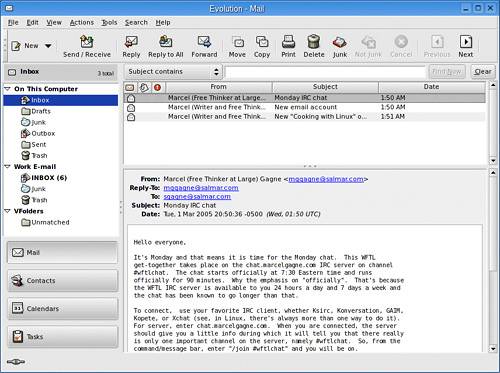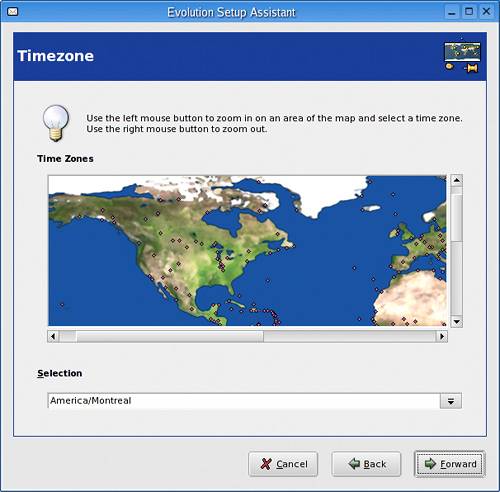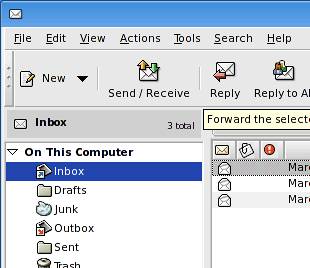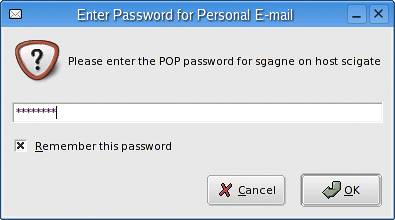Evolution
| What's hard for some people moving to Linux is saying goodbye to certain familiar applications. Two of the most commonly used e-mail packages in the Windows world are Outlook and its cousin, Outlook Express. Those users will feel right at home on their new Linux desktops when they fire up Evolution. Figure 11-16 will no doubt seem extremely familiar. In fact, Evolution looks and feels like Outlook, but with some very important improvements. Figure 11-16. Evolution will make Microsoft Outlook users feel right at home. Once again, it is likely that you will find Evolution on your distribution CD. Another way to get a copy is to head over to
the Web site for the Evolution package.
Upon starting Evolution for the first time, you will be presented with the Evolution Setup Assistant to take you through the various preparatory steps. After clicking Forward through the introductory window, you'll be asked for your default identity. This is where you enter your full name and e-mail address, along with other options, such as a Reply-To address (Figure 11-17). Figure 11-17. Evolution's Setup Assistant. When you are done, click Forward, and it will be time to enter information for receiving mail. You start by selecting a Server Type. For most users, this will be POP or IMAP, as with KMail. Evolution allows you to set up other servers as well, including Novell GroupWise and USENET news. Now enter the hostname of the POP3 or IMAP host (as provided by your ISP) as well as your username. If you don't want to enter your password each and every time Evolution checks for mail, you should click the Remember password checkbox. When you click Forward, you'll have the opportunity to decide whether Evolution checks for mail automatically (the default is to check every 10 minutes). Don't set this unless you are always connected; otherwise you can choose whatever interval suits you. Click Forward again, and you will be able to configure your outgoing mail. The default Server Type for sending is SMTP, and that is almost certainly what you will need. Enter the hostname as provided by your ISP (or system administrator), and click Next. The Account Management screen follows, with your new e-mail account listed as it will be displayed in Evolution. You could change this to be a name rather than an e-mail address if you prefer. When you are done here, click Forward. You are almost done. The final step is to select your time zone. Select an area on the map (preferably near to where you live) to narrow down your search. The map will zoom in to the area you clicked, allowing you to fine-tune your selection (Figure 11-18). Make your final selection (you can use the drop-down box to aid in your selection), click Forward again, then Apply, and you are done. Figure 11-18. Evolution's Setup Assistant zooms in to help in selecting your time zone.
Evolution starts up with a list of resources "On This Computer" highlighted in the left-hand sidebar. The most notable of these resources is, of course, your e-mail (see Figure 11-19). Like the Outlook package in Windows, a set of icons runs down the left-hand sidebar, giving you access to your Calendar, Tasks, Contacts, and e-mail. Figure 11-19. Close-up of "On This Computer."
Sending and Receiving MailTo send a message, start by clicking on the Inbox icon (under the Shortcuts sidebar), and then click the New button just below the menu bar. By default, Evolution creates a new Mail Message, but notice as well that there is a drop-down arrow just beside the word New. Click that arrow, and you can create an appointment (more on that in Chapter 11), a contact, a task, and so on. To create a new mail message, you can also click File on the menu bar and select New and then Mail Message from there. Evolution's compose window will appear (Figure 11-20). Figure 11-20. Sending a message with Evolution the compose window. As with KMail, this is pretty standard stuff. Fill in the person's e-mail address in the To: field, enter a Subject, and type your message. When you have completed your message, click the Send button on the compose window (or click File on the compose window's menu bar and then select Send). To pick up your e-mail, make sure once again that you have the Inbox button selected; then click the Send/Receive button (Figure 11-21) at the top of Evolution's main window (or click Actions on the menu bar and select Send/Receive). Figure 11-21. Click Send/Receive to check for and send e-mail.
The first time you pick up your mail, Evolution will pause and ask you for the password (Figure 11-22). You have an interesting choice to make here. Beside the words Remember this password is a checkbox that lets you lock in the information. If you choose not to record your password with Evolution, you will have to enter your password each time you check for mail. Figure 11-22. Remember the password?
Like Microsoft Outlook, Evolution is an integrated contact management, e-mail, and scheduling system all in one. Aside from basic e-mail functionality, you can plan your day, set alarms, keep a contact list, and more. I discuss some of those capabilities in more detail when I cover ways to stay organized in the next chapter. What to Use?As to whether you use KMail or Evolution (or some of the other options I mention in a moment), this is something you will have to experiment with in order to decide. Personal preference is a huge factor here. I, for one, enjoy the fact that I can run KMail on its own. Historically, I'm not a big fan of integrated clients, but that is strictly a personal preference and one that may change. Others can't imagine using anything other than Evolution, for reasons that are exactly opposite to the one I mentioned. It's your system and your choice. The best way to discover what you want is to try things out. |
EAN: 2147483647
Pages: 247



